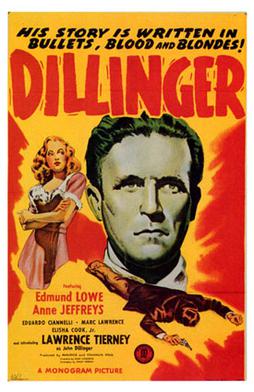Dillinger (1945)
Directed by Max Nosseck
Screenplay by Philip Yordan
Runtime: 1 hr, 10 min
I’m never sure
what to make of America’s fascination with gangsters and bandits. Do people view them as Robin Hood
analogues? They do like targeting the
major financial establishments, even if they aren’t spreading the spoils. Maybe we view these fellows as tragic
figures, people who rise in some field but are done in by some personal flaw. Or it could just be their use of violence;
man is fond of violence. Whatever the
reason, it’s clear that this interest exists.
Why else would there be at least three different films about John
Dillinger simply called Dillinger?
The version I
saw, which I’m told plays fast and loose with the historical record, finds Lawrence
Tierney as the infamous bank robber and Public Enemy No. 1. Arrested for robbing a grocer of $7.20,
Dillinger is sent to prison, where he joins up with a gang of robbers led by
Specs (Edmund Lowe). Once they’re all
out of prison, they set out doing what they do best: robbing banks. Along the way, Dillinger enters a
relationship with a movie ticket saleswoman named Helen (Anne Jeffreys), who,
you guessed it, Dillinger robbed.
I realize that
this is a movie about a robber, but, well, there’s too much robbing in it. Whether it’s that poor grocer or the Farmers
National Bank, there is simply too much time spent on the direct criminal
aspects of the story. The audience is presumably
familiar with John Dillinger’s exploits; I doubt anyone going in thought he was
a congressman. The bank robbing is the
obvious, and hence least interesting, part of his legend. A better question would be, “Who exactly is
John Dillinger, and why’d he get into crime?”
The film doesn’t
really answer that question. Tierney
doesn’t bring a whole lot of depth to the character; all I can gather is that
Dillinger is in a near constant state of annoyance. On top of that, Dillinger gets into crime
very quickly and for seemingly no reason.
One night out drinking he doesn’t have cash on him, so he holds up a
grocer…and now he’s a hardened criminal.
I get the feeling that, even if that is how the physical events played
out, there’s a lot of footage missing from that sequence. Unless he just snapped, of course, but that
raises the question, “Why?”
The origins of
“John Dillinger, Master Stick-Up Artist” may not be explored at all, really,
but I will give the film credit for crafting a nice narrative for his rise to his
gang’s leadership position. Specs begins
as the double-share-taking head honcho, but compared to Dillinger, he’s a
tactical conservative: pass up the highly secured banks, keep the body count as
low as possible, etc. Dillinger, by
contrast, is the group’s daredevil.
He’ll target the big money and is none too cautious with his arms. He’s the group charismatic leader, if you
will, and that gets more attention than careful strategy.
Not to say that
Dillinger himself isn’t a conniving mastermind; he’s just one willing to assume
massive risks. This can be seen in the
famed escape from prison using a hand-carved wooden gun, perhaps the best scene
in the film, and in his thorough casing of the Farmers National Bank. Smart and full of swagger, he’s a legitimate
threat to Specs’ authority in the gang, and the tension between the incumbent
and the challenger propels the action forward, even if the resolution of this
tension is somewhat contrived—the dentist gets involved in the mess.
That Dillinger is at its best when it focuses
on the group’s internal politics is somewhat problematic, however. Once Specs has been permanently removed the
equation, the remainder of the film falls flat.
This is because Dillinger’s relationships with all of the other
characters, from Helen to his new subordinates, are not very well developed. They just serve as tools and obstacles to his
ends. Once his main rival has been taken
care of, it’s “John Dillinger vs. the Authorities”, and I can’t help but root
for the cops here.
In fact, that’s
another boat anchor around the film: we know that Dillinger is going to die,
where he’s going to die, and a whole bunch of other details. Unless the lead up is of particular interest,
that inevitably overrides the goings-on.
I know that once the politics had been swept away, all I was moved to do
was wait for that fated showing of Manhattan
Melodrama. Had Dillinger as a
character been more compelling or perhaps the action a bit more grabbing, that
feeling could have been averted. Instead
it’s like waiting for the guillotine to drop—or, rather, for the cops to show
up.
Granted, this
came out in 1945—maybe the allure of John Dillinger really was that powerful a
little over a decade after his death that his mere presence was compelling
enough for a film. If that’s the case,
then it can be considered a product of its era. And, no, this is not a film that really fails
at filmmaking. But if this film served
as the only evidence of Dillinger in the historical record, I’m fairly certain
that historians would be confused as to how to explain his place in the
American consciousness.

No comments:
Post a Comment